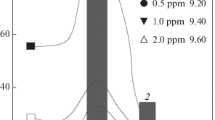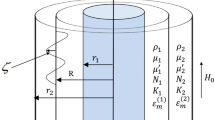Abstract
The disruption of corrosion films formed on copper in flowing aerated 3% NaCl solution has been studied in a flow cell with a rectangular cross section, 50 mm wide x 15 mm. The 140 mm long copper deck and the symmetrical acrylic cover had backward and forward facing 2 mm steps to form a constriction resulting in disturbed flow at the leading edge of the sudden constriction and the sudden expansion. The velocity range based on the unconstricted cross section of the flow cell was 0.3-1.5 m s-1. The development and destruction of the corrosion product films were observed through the transparent cell top. The resulting interactions between the disturbed flow and the films are discussed in terms of the near-wall turbulence parameter profiles, along the length of the flow ceil, calculated by the application of a 2-equation turbulence model with low Reynolds number closure.
Access this chapter
Tax calculation will be finalised at checkout
Purchases are for personal use only
Preview
Unable to display preview. Download preview PDF.
Similar content being viewed by others
References
E. Heitz, “Chemo-mechanical Effects of How on Corrosion”, in Flow-Induced Corrosion: Fundamental Studies and Industry Experience, K. J. Kennelley, R. H. Hausier and D. C. Silverman, eds., NACE, Houston, 1991, 1–1 to 1–29.
J. L. Dawson and C.C. Shih, “Corrosion under Flowing Conditions-An Overview and Model,” ibid, 2–1 –2–12.
E. F. C. Somerscales and H. Sanatgar, “Hydrodynamic Removal of Corrosion Products From a Surface”, British Corrosion Journal, Vol. 27 No. 1, 1992, 36–44.
S. Nesic and J. Postlethwaite, “Relationship Between the Structure of Disturbed Flow and Erosion-Corrosion”, Corrosion, Vol. 46, No 11, 1990, 874–880.
H. Zeisel and F. Durst, “Computations of Erosion-Corrosion Processes in Separated Two-Phase Flows,” in “Flow-Induced Corrosion: Fundamental Studies and Industry Experience”, K. J. Kennelley, R. H. Hausier and D. C. Silverman, eds., NACE, Houston, 1991, 9–1 to 9–21.
S. Nesic and J. Postlethwaite, “A Predictive Model for Erosion-Corrosion,” Corrosion, Vol. 47, No. 8, 1991, 582–591.
S. Nesic, J. Postlethwaite and D. J. Bergstrom, “Calculation of Wail Mass Transfer Rates in Separated Aqueous Flow Using a Low Reynolds Number k-∊ Model”, Int. J. Heat Mass Transfer, Vol. 35, No. 8, 1992, 1977–1985.
A. Cohen, “Corrosion by Potable Water in Building Systems”, Materials Performance, Vol. 32, No. 8, 1993, 56–61.
S. Nesic, G. Adamopoulos, J. Postlethwaite and D. J. Bergstrom, “Modelling of Turbulent Flow and Mass Transfer with Wall function and Low Reynolds Numbers Closures”, Can. J. Chem. Eng., Vol. 71, Feb., 1993, 28–34.
C. K. G. Lam and K. Bremhorst, “A Modified Form of the k-∊ Model for Predicting Wall Turbulence”, ASME J. Fluids Eng., Vol. 103, 1981, 456–460.
U. Lotz and J. Postlethwaite, “Erosion-Corrosion in Disturbed Two Phase Liquid/Particle Flow”, Corrosion Science, Vol. 30, No. 1, 1990, 95–106.
K. D. Efird, “Effect of Fluid Dynamics on the Corrosion of Copper Base Alloys in Sea Water”, Corrosion, Vol. 33, No. 1, 1977, 3–8.
B. C. Syrett, “Erosion-Corrosion of Copper Nickel Alloys in Sea Water and Other Aqueous Environments -A Literature Review”, Corrosion, Vol. 32, No 6, 1976, 242–252.
G. Bianchi, G. Fiori, P. Longhi and F. Mazza, “Horse Shoe Corrosion of Copper Alloys in Flowing Sea Water: Mechanism, and Possibility of Cathodic Protection of Condenser Tubes in Power Stations”, Corrosion, Vol. 34, No 11, 1978, 396–406.
D. D. Macdonald, B. C. Syrett and S. S. Wing, “The Corrosion of Copper Nickel Alloys 706 and 715 in Flowing Sea Water. I -Effect of Oxygen”, Corrosion, Vol. 34, No 9, 1978, 289–301.
C. Loss and E. Heitz, “Zum Mechanismus der Erosionkorrosion in Schnell Strömenden Flüssigkeiten”, Werkestoffe und Korrosion, Vol. 24, No. 1, 1973, 38–48.
U. Lotz and E. Heitz, “Flow Dependent Corrosion. Current Understanding of the Mechanisms Involved”, Werkestoffe und Korrosion, Vol. 34, 1983, 454–461.
T. Sydberger and U. Lotz, “Relation Between Mass Transfer and Corrosion in a Turbulent Pipe Flow”, J. Electrochem. Soc., Vol. 129, No. 2, 1982, 276–283.
A. K. Runchal, “Mass Transfer Investigafion in Turbulent Flow Downstream of Sudden Enlargement of a Circular Pipe for Very High Schmidt Numbers”, Int. J. Heat Mass Transfer, Vol. 14, 1971, 781–792.
R. S. Amano, “A Study of Turbulent Mass Transport Downstream of an Abrupt Pipe Expansion”, Numerical Heat Transfer, Vol. 8, 1985, 361–37 1.
M. Sdeglmeir, C. Tropea, N. Weiser, W. Nitsche, “Experimental Investigafion of the Flow Through Axisymmetric Expansions”, ASME, J. Fluids Eng., Vol. 111, 1989, 464–471.
R. Dworak and H. Wendt, “Stochastic Fluctuations of Mass Transport Through Turbulent Boundary Layers”, Ber. Bunsenges. physik., Vol. 81, No 9, 1977, 864–869.
D. A. Shah and R. A. Antonia, “Scaling of Wall Shear Stress Fluctuations in a Turbulent Duct How”, AIAA J. ,Vol. 25, No. 1, 1986, 22–29.
B. E. Launder, “Second -Moment Closure: Present and Future”, Int. J. Heat and Fluid Flow, Vol. 10, No. 4, 1989, 282–300.
Author information
Authors and Affiliations
Editor information
Editors and Affiliations
Rights and permissions
Copyright information
© 1994 Springer Science+Business Media Dordrecht
About this chapter
Cite this chapter
Postlethwaite, J., Wang, Y., Adamopoulos, G., Nesic, S. (1994). Relationship Between Modelled Turbulence Parameters and Corrosion Product Film Stability in Disturbed Single-Phase Aqueous Flow. In: Trethewey, K.R., Roberge, P.R. (eds) Modelling Aqueous Corrosion. NATO ASI Series, vol 266. Springer, Dordrecht. https://doi.org/10.1007/978-94-011-1176-8_14
Download citation
DOI: https://doi.org/10.1007/978-94-011-1176-8_14
Publisher Name: Springer, Dordrecht
Print ISBN: 978-94-010-4513-1
Online ISBN: 978-94-011-1176-8
eBook Packages: Springer Book Archive




